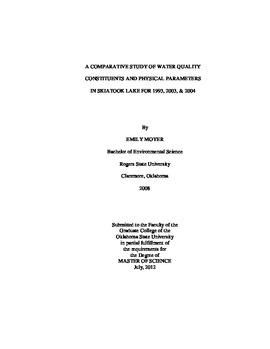| dc.contributor.advisor | Clyde, Tony | |
| dc.contributor.author | Moyer, Emily Dawn | |
| dc.date.accessioned | 2014-04-15T22:31:47Z | |
| dc.date.available | 2014-04-15T22:31:47Z | |
| dc.date.issued | 2012-07-01 | |
| dc.identifier.uri | https://hdl.handle.net/11244/9565 | |
| dc.description.abstract | Skiatook Lake, located in Osage County, Oklahoma, was impounded in 1984. Its main purposes were to provide water supply, flood control, and fish and wildlife habitat. It also provides for many recreational activities for the public. Anthropogenic and non-anthropogenic activities can cause an increase in nutrients entering surface water over time. This paper analyzed any change in concentrations that occurred, also accounted for no change that occurred in Skiatook Lake between the years 1993 and 2003-2004. The water quality parameters used were total phosphorus, total Kjeldahl nitrogen, turbidity, and Secchi depths. Data for the project was provided by the U.S. Army Corps of Engineer. A positive correlation was established for total phosphorus and turbidity in the given sampling period. Data was combined for all 3 years and each parameter was analyzed using an analysis of variance (ANOVA). The significance was measured at =0.05. The analysis of data collected from the years 1994, 2003, and 2004 show a significant increase (p=0.776) in TP, no significant change in TKN (p=0.0001), and a significant increase in turbidity (p=0.77). However, Secchi readings conclude that the overall clarity of the lake from east to west, along transactional cross-sections demonstrate the dynamics of the lake. Grab sampling efforts are random and may miss important collection periods. There can be holes in the data, creating potential bias. Benefits for using continuous monitoring year round are widespread. Seasonal trends may be more easily detected, effects of rainfall events are captured, and fewer personnel are needed. Best management practices can be implemented if needed in response to any water quality shifts. The findings in this study have indicated some decrease in water quality, whereas some characteristics remain the same. Continued analysis of water quality is vital. Additional analysis of individual sites will be very beneficial. | |
| dc.format | application/pdf | |
| dc.language | en_US | |
| dc.publisher | Oklahoma State University | |
| dc.rights | Copyright is held by the author who has granted the Oklahoma State University Library the non-exclusive right to share this material in its institutional repository. Contact Digital Library Services at lib-dls@okstate.edu or 405-744-9161 for the permission policy on the use, reproduction or distribution of this material. | |
| dc.title | Comparative Study of Water Quality Constituents and Physical Parameters in Skiatook Lake for 1993, 2003, and 2004 | |
| dc.type | text | |
| dc.contributor.committeeMember | Gustavson, Kevin | |
| dc.contributor.committeeMember | Rossman, Edwin | |
| osu.filename | Moyer_okstate_0664M_12297.pdf | |
| osu.college | Agricultural Sciences and Natural Resources | |
| osu.accesstype | Open Access | |
| dc.description.department | Environmental Sciences Program | |
| dc.type.genre | Thesis | |
| dc.subject.keywords | chlorophyll a | |
| dc.subject.keywords | secchi disk | |
| dc.subject.keywords | skiatook lake | |
| dc.subject.keywords | total kjeldahl nitrogen | |
| dc.subject.keywords | total phosphorus | |
| dc.subject.keywords | turbidity | |
